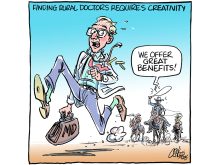In their enthusiasm to build a new political party to challenge the governing federal Liberals, Reformers have floated one of the oddest political ideas to surface in a while – a confederal party.
It is an unwise and distasteful concept on a number of fronts, reducing Canada to nothing more than the sum of its perpetually-aggrieved regional parts.
But it does add some entertainment value to Canadian politics. Winter-weary Canadians should take their laughs where they can get them.
When they gather in Ottawa a month from now to talk about creating a “united alternative” political force to take on the Liberals in 2001, one of the ideas to be put before the expected 1,500 delegates is creation of a confederal party.
Read Also

Kochia has become a significant problem for Prairie farmers
As you travel through southern Saskatchewan and Alberta, particularly in areas challenged by dry growing conditions, the magnitude of the kochia problem is easy to see.
It would be a coalition of five regional parties from British Columbia, the Prairies, Ontario, Quebec and Atlantic Canada. Each regional party would elect a leader, who would be deputy leader of the national party. A so-called “national” leader would be elected by members of the five regional parties.
A discussion paper prepared for the convention suggests Reform might be the regional party for B.C. and the Prairies. The Progressive Conservatives could represent the Atlantic provinces.
New parties, perhaps amalgamations like the Saskatchewan Party, would be formed in Ontario and Quebec.
Some organizers have suggested the separatist Bloc QuŽbecois might morph into the Quebec section if it gave up independence as a goal and contented itself with simply emasculating the federal government.
This new creation would, said the discussion paper, “offer strong regional identities as part of a new overall national coalition, while creating the basis for the strongest, most deeply rooted national party in Canadian politics.”
The image of five cats fighting under a blanket seems more appropriate.
It sounds like the “state rights” theories of the United States, which helped lead to the civil war and deeply influenced the thinking of the colonial politicians who drew up the blueprint for Canada and who decided they would not recreate the model of a weak centre and strong parts.
But the flaw in this idea goes well beyond its ahistorical vanities.
It also plays to one of Brian Mulroney’s great errors – imagining that Quebec separatists could be enticed to stay loyal Canadians if you simply make Ottawa weaker and Canada less relevant.
University of Manitoba political scientist Paul Thomas puts his finger on the flaw in Preston Manning’s attempt to resurrect Mulroney’s national policy.
He seems to think Quebec nationalists and conservative Prairie populists are aligned in dreaming of a more decentralized Canada.
But Prairie populists base their policy on the theology of provincial equality while Quebec nationalists preach a theology of two equal nations – Quebec and the “Rest Of Canada.”
These are not compatible theologies.
Regional grievances do not create national vision. And Canada is more than the sum of its regions.
















